人教版(2019)选择性必修 第二册Unit 3 Food and Culture Reading and Thinking 1 课件(共21张PPT)
文档属性
| 名称 | 人教版(2019)选择性必修 第二册Unit 3 Food and Culture Reading and Thinking 1 课件(共21张PPT) | 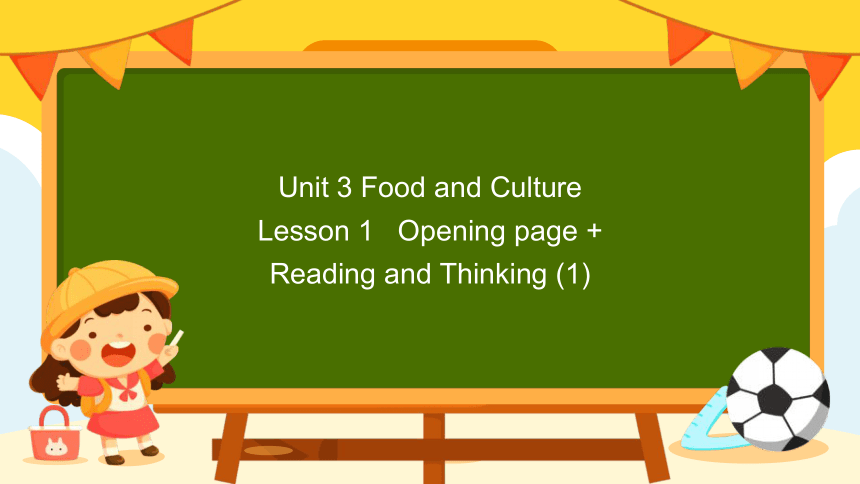 | |
| 格式 | pptx | ||
| 文件大小 | 17.3MB | ||
| 资源类型 | 教案 | ||
| 版本资源 | 人教版(2019) | ||
| 科目 | 英语 | ||
| 更新时间 | 2025-03-02 14:50:21 | ||
图片预览

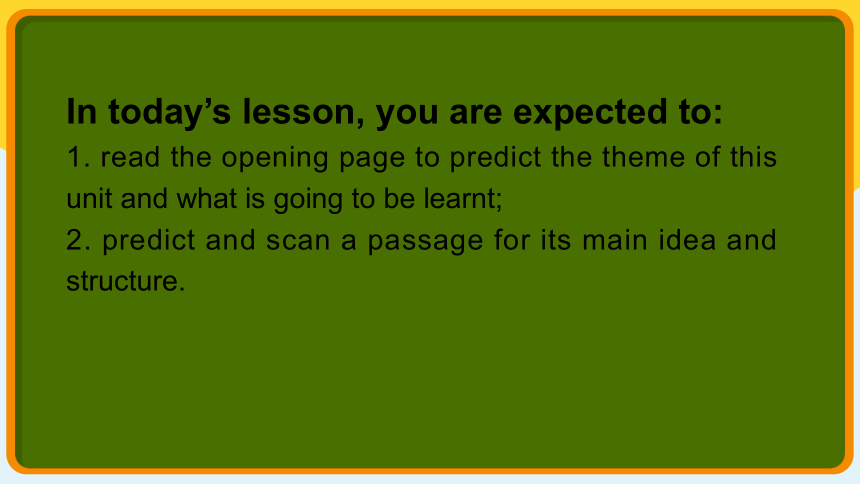
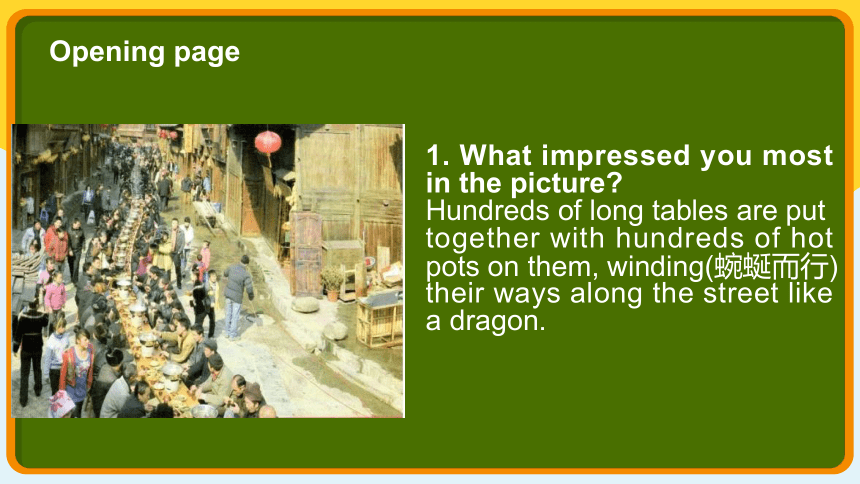
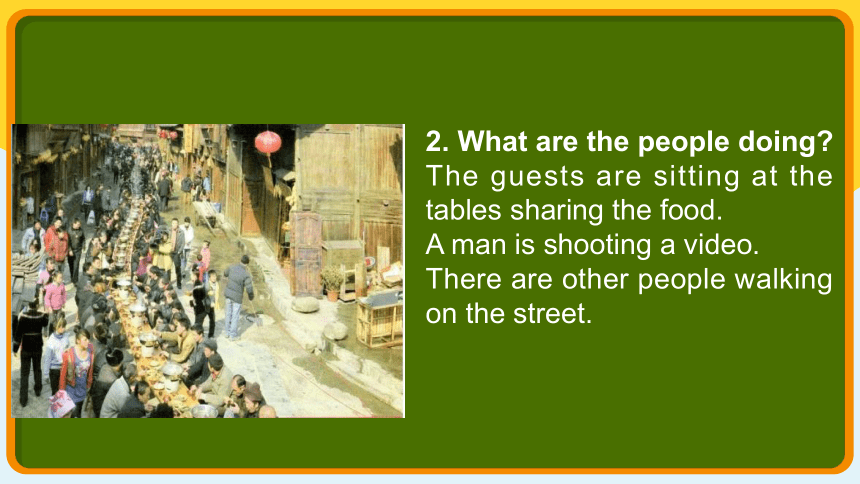

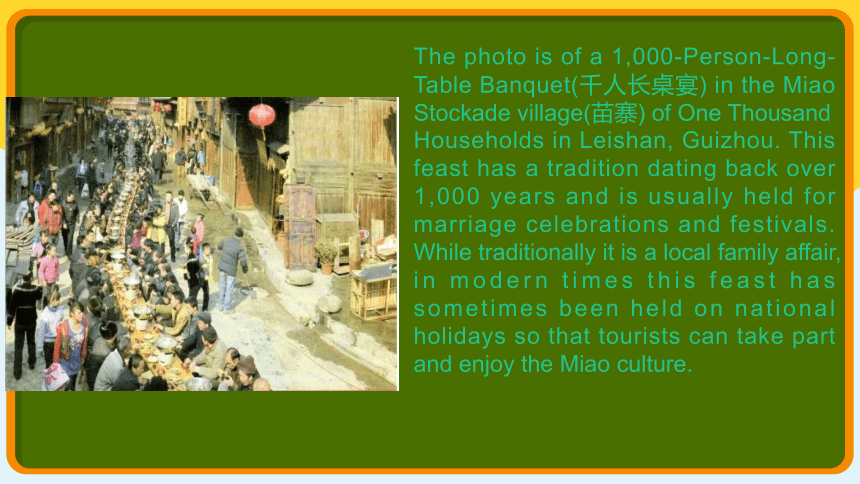
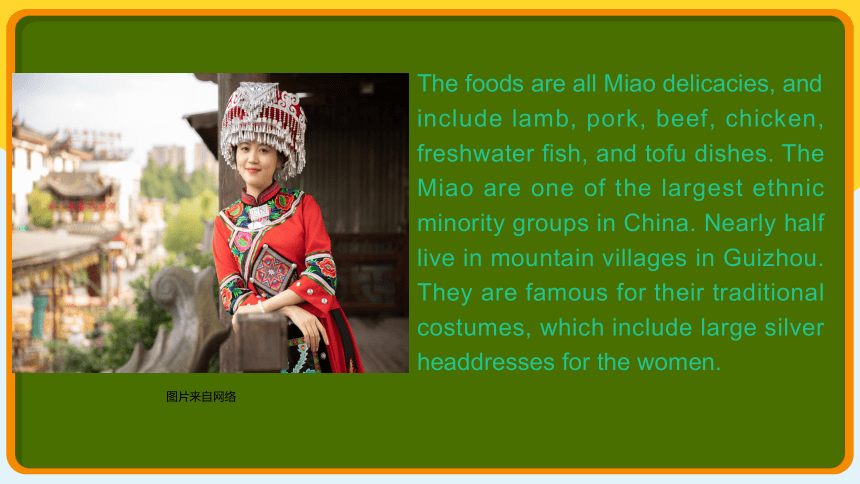

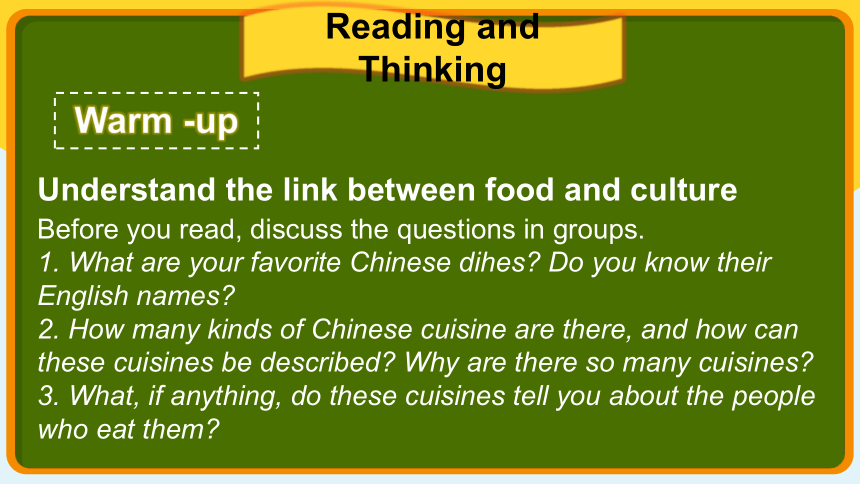
文档简介
(共21张PPT)
Unit 3 Food and Culture
Lesson 1 Opening page +
Reading and Thinking (1)
In today’s lesson, you are expected to:
1. read the opening page to predict the theme of this unit and what is going to be learnt;
2. predict and scan a passage for its main idea and structure.
1. What impressed you most in the picture
Hundreds of long tables are put together with hundreds of hot pots on them, winding(蜿蜒而行) their ways along the street like a dragon.
Opening page
2. What are the people doing
The guests are sitting at the tables sharing the food.
A man is shooting a video.
There are other people walking on the street.
3. Where and when do you think the photo was taken
Maybe it was taken in an ethnic minority village in the mountains of China. We can see tables laid end to end without a gap along the street like a long dragon, and local people are enjoying the long table banquet. The visual spectacle, made of assorted delicacies(各种美味佳肴) and people sitting together , is really breathtaking.
The photo is of a 1,000-Person-Long-Table Banquet(千人长桌宴) in the Miao Stockade village(苗寨) of One Thousand Households in Leishan, Guizhou. This feast has a tradition dating back over 1,000 years and is usually held for marriage celebrations and festivals. While traditionally it is a local family affair, in modern times this feast has sometimes been held on national holidays so that tourists can take part and enjoy the Miao culture.
The foods are all Miao delicacies, and include lamb, pork, beef, chicken, freshwater fish, and tofu dishes. The Miao are one of the largest ethnic minority groups in China. Nearly half live in mountain villages in Guizhou. They are famous for their traditional costumes, which include large silver headdresses for the women.
图片来自网络
4. How do you understand the quote Can you give some examples of the different levels on which food brings people together
Food not only provides nutrition for people’s mental and physical health, but also plays an important role in maintaining their social and cultural bonds. So often people show and receive love through food. In this sense, food feeds both the body and the heart.
In a traditional society, cooking food is a way to show love to the family. The memories of the food, the old recipes, and the times spent together become treasured aspects of life.
Reading and Thinking
Understand the link between food and culture
Before you read, discuss the questions in groups.
1. What are your favorite Chinese dihes Do you know their English names
2. How many kinds of Chinese cuisine are there, and how can these cuisines be described Why are there so many cuisines
3. What, if anything, do these cuisines tell you about the people who eat them
Warm -up
本页图片均来自网络
Stewed noodles
Hand-torn cabbage
Dim sum
Red braised pork
Steamed fish
Hot pot
How many kinds of Chinese cuisines in China
How can these cuisine be described
Why are there so many cuisines
本页图片均来自网络
图片来自网络
Different regions
Various weather conditions
Different preferences in flavours
Different personalities
Different ingredients
图片来自网络
3. What, if anything, do these cuisines tell you about the people who eat them
The cuisines certainly say something about the kinds of ingredients available to the people, and a lot about the kinds of flavours the people prefer.
Jean Anthelme Brillat-Savarin (1755-1826) was a French lawyer and politician who was also a great lover of food. He wrote numerous books on many subjects, but is best remembered for The Psychology of Taste in English. As a series of philosophical essays on the relationship between culture and food, this was one of the books which created the genre of food writing.
Cultural notes
Match the main idea with each paragraph.
Para.1
Para.2
Para.3
Para.4
Para.5
Para.6
Para.7
A. Famous food in Xinjiang.
B. Famous food in Shandong.
C. Food in South and central China.
D. Culture and cuisine go hand in hand.
E. Experience of Chinese dishes in America.
F. Experience of Sichuan food in Beijing.
G. You are what you eat.
Part 2 (paras 2-6): My experiences with Chinese food.
Part 1 (para 1): Introduction of the topic: you are what you eat.
Part 3 (para7): Conclusion: culture and cuisine go hand in hand.
General
Particular
General
3.What is the writer’s purpose in writing the passage How does he achieve his purpose
To inform us of the fact: culture and cuisine go hand in hand. He achieves his purpose by giving examples of his experiences with Chinese food.
4. What is the text type of the passage
The reason why the writer tells us about his experiences is that in this way, he can make us better understand the link between food and culture. So it is a piece of expository writing(说明文).
Reading for structure and text type
In today’s lesson, we
1. got to know the 1,000-Person-Long-Table Banquet(千人长桌宴) in the Miao Stockade village(苗寨);
2. briefly discussed about China’s eight cuisines;
3. read a passage about food and culture for its main idea and structure.
Summary
Homework
1. Follow the recording to read the text aloud several times and review the important words and phrases learnt in this period .
Topic: ______________________
Chinese food in America
__________________
in Beijing
in Shandong
in ___
in ___
in Henan
Conclusion:__________________________
2. Finish the following mind map according to the text.
Unit 3 Food and Culture
Lesson 1 Opening page +
Reading and Thinking (1)
In today’s lesson, you are expected to:
1. read the opening page to predict the theme of this unit and what is going to be learnt;
2. predict and scan a passage for its main idea and structure.
1. What impressed you most in the picture
Hundreds of long tables are put together with hundreds of hot pots on them, winding(蜿蜒而行) their ways along the street like a dragon.
Opening page
2. What are the people doing
The guests are sitting at the tables sharing the food.
A man is shooting a video.
There are other people walking on the street.
3. Where and when do you think the photo was taken
Maybe it was taken in an ethnic minority village in the mountains of China. We can see tables laid end to end without a gap along the street like a long dragon, and local people are enjoying the long table banquet. The visual spectacle, made of assorted delicacies(各种美味佳肴) and people sitting together , is really breathtaking.
The photo is of a 1,000-Person-Long-Table Banquet(千人长桌宴) in the Miao Stockade village(苗寨) of One Thousand Households in Leishan, Guizhou. This feast has a tradition dating back over 1,000 years and is usually held for marriage celebrations and festivals. While traditionally it is a local family affair, in modern times this feast has sometimes been held on national holidays so that tourists can take part and enjoy the Miao culture.
The foods are all Miao delicacies, and include lamb, pork, beef, chicken, freshwater fish, and tofu dishes. The Miao are one of the largest ethnic minority groups in China. Nearly half live in mountain villages in Guizhou. They are famous for their traditional costumes, which include large silver headdresses for the women.
图片来自网络
4. How do you understand the quote Can you give some examples of the different levels on which food brings people together
Food not only provides nutrition for people’s mental and physical health, but also plays an important role in maintaining their social and cultural bonds. So often people show and receive love through food. In this sense, food feeds both the body and the heart.
In a traditional society, cooking food is a way to show love to the family. The memories of the food, the old recipes, and the times spent together become treasured aspects of life.
Reading and Thinking
Understand the link between food and culture
Before you read, discuss the questions in groups.
1. What are your favorite Chinese dihes Do you know their English names
2. How many kinds of Chinese cuisine are there, and how can these cuisines be described Why are there so many cuisines
3. What, if anything, do these cuisines tell you about the people who eat them
Warm -up
本页图片均来自网络
Stewed noodles
Hand-torn cabbage
Dim sum
Red braised pork
Steamed fish
Hot pot
How many kinds of Chinese cuisines in China
How can these cuisine be described
Why are there so many cuisines
本页图片均来自网络
图片来自网络
Different regions
Various weather conditions
Different preferences in flavours
Different personalities
Different ingredients
图片来自网络
3. What, if anything, do these cuisines tell you about the people who eat them
The cuisines certainly say something about the kinds of ingredients available to the people, and a lot about the kinds of flavours the people prefer.
Jean Anthelme Brillat-Savarin (1755-1826) was a French lawyer and politician who was also a great lover of food. He wrote numerous books on many subjects, but is best remembered for The Psychology of Taste in English. As a series of philosophical essays on the relationship between culture and food, this was one of the books which created the genre of food writing.
Cultural notes
Match the main idea with each paragraph.
Para.1
Para.2
Para.3
Para.4
Para.5
Para.6
Para.7
A. Famous food in Xinjiang.
B. Famous food in Shandong.
C. Food in South and central China.
D. Culture and cuisine go hand in hand.
E. Experience of Chinese dishes in America.
F. Experience of Sichuan food in Beijing.
G. You are what you eat.
Part 2 (paras 2-6): My experiences with Chinese food.
Part 1 (para 1): Introduction of the topic: you are what you eat.
Part 3 (para7): Conclusion: culture and cuisine go hand in hand.
General
Particular
General
3.What is the writer’s purpose in writing the passage How does he achieve his purpose
To inform us of the fact: culture and cuisine go hand in hand. He achieves his purpose by giving examples of his experiences with Chinese food.
4. What is the text type of the passage
The reason why the writer tells us about his experiences is that in this way, he can make us better understand the link between food and culture. So it is a piece of expository writing(说明文).
Reading for structure and text type
In today’s lesson, we
1. got to know the 1,000-Person-Long-Table Banquet(千人长桌宴) in the Miao Stockade village(苗寨);
2. briefly discussed about China’s eight cuisines;
3. read a passage about food and culture for its main idea and structure.
Summary
Homework
1. Follow the recording to read the text aloud several times and review the important words and phrases learnt in this period .
Topic: ______________________
Chinese food in America
__________________
in Beijing
in Shandong
in ___
in ___
in Henan
Conclusion:__________________________
2. Finish the following mind map according to the text.
